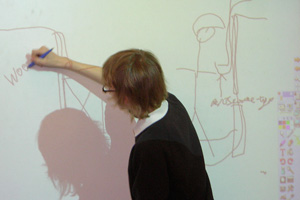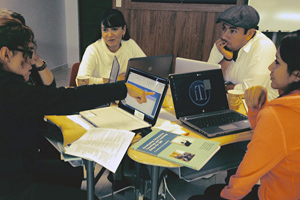About the Project

Focus
In this project three researchers based at the University of Cambridge worked collaboratively with three experienced practitioners and their classes of 10- to 14-year-olds. We investigated how the interactive whiteboard can be used to help teachers wanting to encourage dialogue in their classrooms.
What exactly is dialogue?

Classroom dialogue means the ways that teachers and students explore and generate ideas and questions together. Dialogue isn’t straightforward talk, it’s where participants make their reasoning clear to each other – and most importantly, they build on and critique others’ ideas as well as their own. Teachers can support this with open-ended, thought-provoking questioning, while students get to take extended turns in group and whole class discussions. (Interested readers might like to see the ‘Dialogic Teaching’ booklet by Robin Alexander (http://www.robinalexander.org.uk/publications/) which outlines the approach in an accessible way; see also the free downloadable classroom materials from http://www.thinking-together.org.uk/.
Why use the interactive whiteboard for this?
 We hear a lot about “interactive whole class teaching” these days. However research shows that in practice it’s often dominated by too fast, closed questioning led by the teacher – with little opportunity for dialogue in which students contribute their own ideas.
We hear a lot about “interactive whole class teaching” these days. However research shows that in practice it’s often dominated by too fast, closed questioning led by the teacher – with little opportunity for dialogue in which students contribute their own ideas.
The interactive whiteboard (IWB) can help teachers offer this opportunity though; it seems like the perfect space for children to communicate their ideas visually and for a class to build up knowledge together.
In principle the IWB lends itself to more interactivity and use by students, but again we often see only teachers using it or students engaged in rather superficial activity.
We have the boards in almost all our schools in the UK now, and in the vast majority of classrooms; they are multiplying like rabbits. But policymakers need to realise that simply plonking these powerful tools into classrooms won't change teaching and learning by itself! How the teachers and learners use them is absolutely key. Our project asked:
How can teachers use the IWB purposefully to help get students talking and thinking in more depth, testing out ideas, and learning from their classmates?
Who took part and what did we do?

Three university researchers worked with three primary, middle school and secondary teachers. We picked our case study teachers carefully; they were daily IWB users and good teachers who already supported dialogue in their classrooms, and they were keen to develop this practice by working out some new ways to use the technology.
We worked closely together in a series of workshops to explore what new kinds of dialogue might emerge when an IWB was used purposefully, for example how learners might build on what others draw or write on the board as well as what they say. Then the teachers designed short lesson sequences to try out the new ideas in their own subject areas. The learning activities were based on a dialogic approach.
They took advantage of the unique features of the IWB technology that allowed the class to interact with a wide range of graphical, video, audio, text, animation (“multimodal”) resources. The teachers themselves give some examples of their practices overleaf. Along the way we jointly built up a table summarising the conditions, typical activities and goals of these dialogic classrooms.
Follow-up work

The project culminated in a multimedia resource for school-based continuing professional development co-authored by our project team of academics and participating teachers, and published in 2014 as a book with accompanying online resources. After piloting the CPD programme in a couple of schools, we carried out an ESRC-funded impact project to evaluate changes in teachers’ thinking and practice as a consequence of participating in the workshop-based programme, using our printed and online resources. The study involved 80 teachers from 14 schools in 5 clusters. Findings showed that the professional development workshop model has a positive impact on the quality of classroom dialogue.
